Grand Winner: Affordable
Location: San Francisco
Developers: BRIDGE Housing Corp.; Community Housing Partnership
Architect: Leddy Maytum Stacy Architects
Builder: Cahill Contractors
Opened: December 2013
Number of units: 120
Unit mix: Studios and one-bedrooms
Rent: $375 (average)
In Rene Cazenave Apartments, San Francisco’s formerly homeless population has a new place to call their own.
After being selected by the San Francisco Redevelopment Agency, nonprofits BRIDGE Housing Corp. and Community Housing Partnership worked together to create a development dedicated to serving extremely low-income individuals without stable housing. Residents are exclusively referred and supported by the Department of Public Health’s (DPH’s) Direct Access to Housing program. Through outreach to service providers for the chronically homeless, DPH identifies candidates for the program and certifies their income, housing, and disability status before referral.
Accommodations for residents include more than just the apartments themselves; counseling and nursing services are provided on site through the University of California–San Francisco’s Citywide Case Management Services. There are units reserved for individuals with mobility or sensory impairments and those with HIV/AIDS, and the entire building was designed in accordance with ADA accessibility guidelines.
Common areas such as the resident lounge, courtyard, and community garden provide gathering places for tenants as well as attractive additions to the building. Street-level retail and expanded sidewalks also add value to the Folsom Street corridor, which is part of the project’s goal as one of the first major developments in the Transbay Redevelopment Area of San Francisco.
Though affordable housing is the focus, the building boasts many state-of-the-art features, including solar thermal and photovoltaic hot-water and electric systems; a separate graywater plumbing system; and a green roof. Additionally, a post-tensioned concrete lateral structural system greatly limits drift following an earthquake and allows occupants to shelter in place during the event—a rarity for public housing projects.
This admirable feat is proof that it isn’t necessary to sacrifice aesthetics, sustainability, or amenities in order to provide support and shelter for an underserved population.
